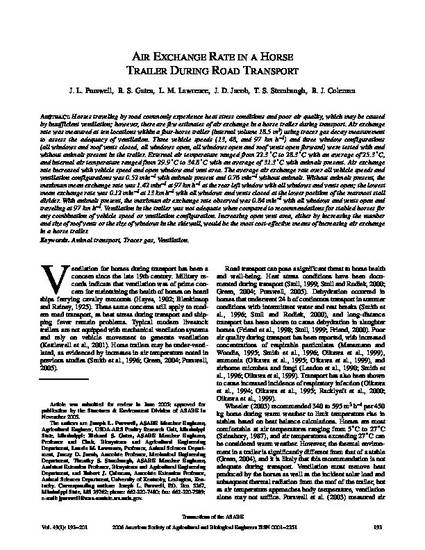
Horses traveling by road commonly experience heat stress conditions and poor air quality, which may be caused by insufficient ventilation; however, there are few estimates of air exchange in a horse trailer during transport. Air exchange rate was measured at ten locations within a four-horse trailer (internal volume 18.5 m3) using tracer gas decay measurement to assess the adequacy of ventilation. Three vehicle speeds (13, 48, and 97 km h-1) and three window configurations (all windows and roof vents closed, all windows open, all windows open and roof vents open forward) were tested with and without animals present in the trailer. External air temperature ranged from 22.3°C to 28.3°C with an average of 25.3°C, and internal air temperature ranged from 29.9°C to 34.8°C with an average of 31.3°C with animals present. Air exchange rate increased with vehicle speed and open window and vent area. The average air exchange rate over all vehicle speeds and ventilation configurations was 0.52 min-1 with animals present and 0.76 min-1 without animals. Without animals present, the maximum mean exchange rate was 1.42 min-1 at 97 km h-1 at the rear left window with all windows and vents open; the lowest mean exchange rate was 0.12 min-1 at 13 km h-1 with all windows and vents closed at the lower position of the rearmost stall divider. With animals present, the maximum air exchange rate observed was 0.84 min-1 with all windows and vents open and traveling at 97 km h-1. Ventilation in the trailer was not adequate when compared to recommendations for stabled horses for any combination of vehicle speed or ventilation configuration. Increasing open vent area, either by increasing the number and size of roof vents or the size of windows in the sidewall, would be the most cost-effective means of increasing air exchange in a horse trailer.
Available at: http://works.bepress.com/richard-gates/95/

Published in Transactions of the ASABE, v. 49, issue 1, p. 193-201.
The copyright holder has granted the permission for posting the article here.